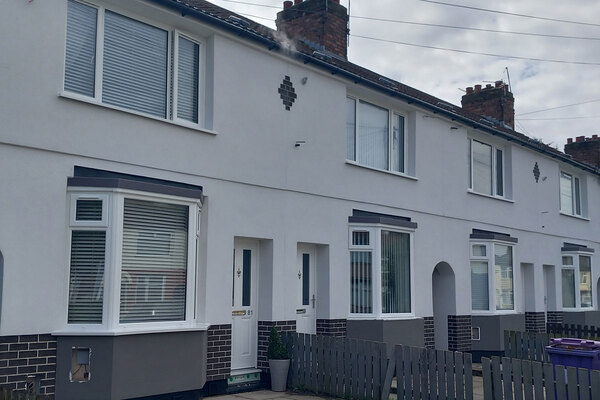Reframing retrofit could protect UK households and the economy
Annisa Sekaringtas, programme manager at the Cambridge Institute for Sustainability Leadership, says retrofit is a critical lever for health, resilience and financial stability
Britain’s homes are unprepared for the climate crisis. Our ageing housing stock is increasingly exposed to cold, damp winters, summer heatwaves and record flooding. This is clearly on the government’s radar - the recently announced Spending Review gave a welcome £13.2bn boost to the Warm House Plan, but there is both the potential and the need to do. UK households face rising energy bills in draughty homes and worsening damp and mould; their health and financial strain is already mounting.
Between 2023 and 2024, over 7,000 homes across England were flooded during the wettest 18-month period on record. Storms like Babet and Ciaran triggered £585 million in insurance payouts. Yet these figures barely capture the real cost: families displaced, possessions destroyed, and lives disrupted for months. And the risks are escalating. By 2050, one in four UK homes could be affected by floods. Meanwhile, insurance premiums have risen by 16 per cent in a single year. In the US, Australia and New Zealand, uninsurable homes are no longer theoretical – they are appearing on the map.
But there is a solution in hand. When done right, renovating or retrofitting homes so they are able to cope with climate change can deliver not just an environmental fix, but also a strategic investment into public health, economic resilience and financial stability. By expanding the view of how we see the benefits of retrofit into one that considers the full aspect of people’s well-being and resilience we can engage banks, insurers and investors in support. And in doing so, these financial companies can also help protect themselves against the rising risks of climate change.
Enter integrated retrofit
The current retrofit narrative is dominated by energy efficiency. Important as this is, it’s incomplete. The homes of the future also need to be protected from overheating and flooding, and designed to support health and affordability across all income levels. That means ensuring good indoor air quality and thermal comfort, alongside ventilation, shading and flood protection.
Integrated retrofit pays dividends. A study of Bristol buildings shows that ignoring future climate impacts can underestimate retrofit costs by up to 55%. By addressing health, resilience, carbon and cost together, an integrated approach can deliver far greater long-term value.
Consider flood resilience: every £1 spent on flood-proofing a property yields £5 in avoided damages. Warmer, drier homes cut hospital admissions, improve productivity, and support borrowers’ ability to repay mortgages. Meanwhile, fuel poverty, damp-related illness, and poor thermal comfort already cost the NHS billions yearly.
There’s also a macroeconomic dividend. The retrofit sector – construction, design, technology, finance – could become a growth engine, generating thousands of skilled jobs and positioning the UK as a leader in green finance. With proper planning, it could be reflected in national growth forecasts, as housing reform did in the 2025 Spring Budget.
The role of finance: aligning capital with resilience
The financial sector is uniquely positioned to accelerate this transformation. Banks, building societies and insurers hold the levers to embed retrofit into mainstream finance, while also protecting their own balance sheets.
Lenders can integrate retrofit incentives directly into products. Offering preferential rates for home improvements that increase resilience and energy standards, and embedding upgrade finance into the homebuying process, helps align loan performance with long-term asset quality. Importantly, this transition must be inclusive. Financial incentives should reward improvement, not penalise those who cannot act immediately. Without thoughtful design, we risk creating a new class of “mortgage prisoners” trapped in vulnerable, low-value homes that cannot attract affordable finance.
Insurers, meanwhile, need to evolve underwriting models to recognise retrofit as a risk-reducing measure and support long-term coverage in a riskier climate. Those who do can benefit from lower claims, more stable premiums and stronger customer retention. Insurers can also integrate resilience into claims handling and drive up standards through their supply chains.
Some banks are already issuing sustainability‑linked loans to social housing providers. The next step is scaling those products for the wider market. Surveys suggests seven in ten homeowners want their bank’s help to retrofit. This is a demand waiting for a market.
Government leadership is key
The private sector cannot drive this transformation alone. Government need to align incentives, correct market failures, and stimulate demand at scale.
That means a long-term national retrofit strategy, building on the progress made by the Warm Homes Plan, reforming EPC and building standards, decoupling electricity and gas prices, so clean heating is not penalised, and leveraging public finance to crowd in private capital. Local authority support and public education will also be vital to scale delivery and ensure a just transition.
Currently, fragmented policymaking is holding us back. The Energy Security and Net Zero Committee recently highlighted that poor-quality retrofit (eg, faulty solid wall insulation) has led to damp, mould, and structural damage. These failures erode public trust and slow momentum.
An inclusive retrofit strategy is key, and the government needs to ensure that policy designs and public funds are directed to those who need them the most. For instance, by continuing to ensuring grants are targeted at low-income, high-risk communities. Policies need to ensure that vulnerable communities are not left behind.
Critically, the government must establish retrofit as a material component of national economic and industrial policy. This is not a marginal issue, it is central to energy security, health equity, housing affordability and long-term financial stability.
Retrofit as a national asset
Retrofitting the UK’s homes is not just about cutting emissions; it’s about ensuring that homes remain safe, insurable, affordable and comfortable in a warming world. As we set out in our report ‘Business Case for Intergrated Retrofit,’ it’s about building an economy that is physically, financially and socially resilient in a warming world.
Banks and insurers don’t just stand to benefit from this transition, they are critical to enabling it. With the right incentives, integrated data, and a shared vision, the financial sector can become a catalyst for a healthier, more prosperous, and climate-resilient Britain.
The question is not whether we can afford to invest in retrofit. The real question is: can we afford not to?



